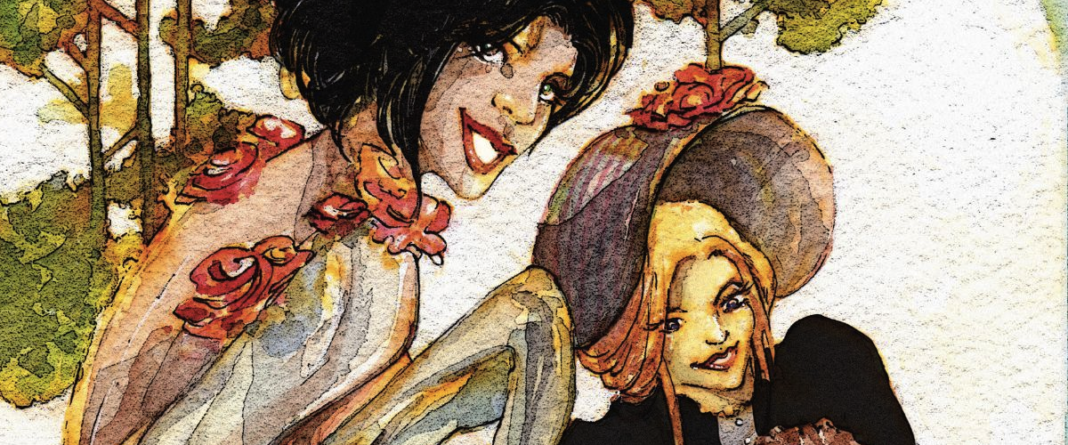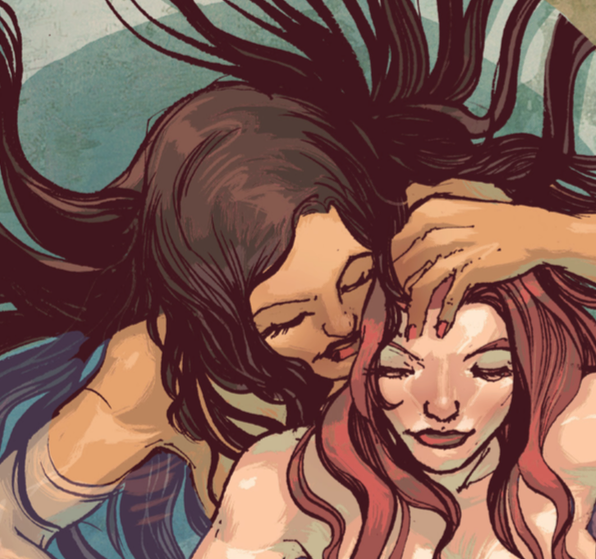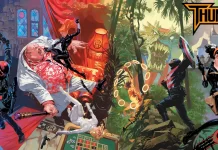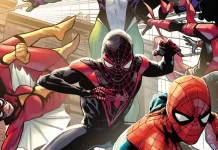Welcome to Queerness In Comics, a bi-weekly column by Avery Kaplan, which will explore queer representation in comics. This week, Avery is exploring InSEXts, published from 2015-2017.
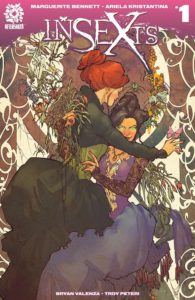
Artist: Ariela Kristantina
Color Artist: Bryan Valenza (1-5) & Jessica Kholinne (6-13)
Publisher: AfterShock Comics
It may be true that the course of true love never ran smooth – but sometimes it gets really, really messy. Set in the Victorian era, InSEXts is an erotic gothic horror story that uses its awareness of the genre’s conventions to subvert expectations and tell a tale of two women who will go to extraordinary lengths in order to protect each other and their child. InSEXts is from writer Marguerite Bennett, artist Ariela Kristantina, with colors by Bryan Valenza and Jessica Kholinne. As the title might suggest, the larvae should be put to bed before fetching this volume from the shelf – it is decidedly not an all-ages comic!
Victorian London
InSEXts begins in London in 1894, a period of history often known as the fin de siècle or the end of the century. It was a time of cultural upheaval: as the control of the British empire declined around the planet, anxiety about shifting power structures and uncertainty about what shape the future would take were both widespread.
As Victorian London confronted the reality of its decline in power, the culture faced something of an existential crisis. Anxieties were directed both inward and out: by identifying certain groups of people as “the Other,” those who feared they would lose their control over the world could assign responsibility for what they perceived to be society’s ills. Two of the most common scapegoats were women, particularly those who dared demonstrated any measure of autonomy, and anyone London culture considered to be foreigners.
Gothic Horror
These fears are reflected by contemporary Victorian gothic horror. In 1897’s Dracula, Bram Stoker took advantage of anxiety about foreign invaders – it is no coincidence that the titular title vampire originates in Eastern Europe before invading London. It is also no coincidence that the Count targets the women, or the effect his attack has on them.
After Lucy Westenra falls under Dracula’s thrall and becomes a creature of the night she is dispatched by her former lover, Arthur. As the men survey Lucy’s undead body in her churchyard tomb, the text takes time to reflect on how Dracula’s influence has corrupted her “purity,” describing her “voluptuous mouth” and “carnal” appearance. It is only after Arthur hammers a stake through her heart that Lucy’s “purity” can be restored.
After being staked, Lucy is no longer an impure “Thing,” but has been returned to the “unequaled sweetness and purity” that defined her before Dracula’s intervention. Gone are the sensual descriptors: while the vampire’s influence had “corrupted” Lucy with sexuality (which the men in her life could not control), the heroic actions of her betrothed are sufficient to deliver her soul to rest, if not to save it.
Status Quo
At the beginning of InSEXts, Lady Bertram is married to Harry, a Viscount who derides her for being “barren” and insists that he would be content if she could only “give him a child.” But from the very first pages we learn that although Lady Bertram is married to the Viscount, her heart belongs to Mariah, her maid and clandestine lover.
Mariah offers her a solution, telling her that she can provide her with a child, and during the ensuing sex scene, Mariah passes an object from her mouth to Lady Bertram’s. This “egg sac” is then used to forcibly impregnate Harry, who finds himself the unwilling womb to Lady Bertram’s child – an inversion of the same fate he had attempted to force upon his wife.
The child is born soon after (a process Harry does not survive – think Alien, but gorier). But while the late Viscount served as the womb for their baby, dialogue between Mariah and Lady confirm that the child is theirs, possessing Lady’s hair and Mariah’s eyes – and none of Harry’s traits.
Initially, Harry’s expectation was that he would exert control over his wife by impregnating her with his child. However, thanks to the queer romance between Mariah and Lady, as well as a magic object Mariah obtained in Burma, his expectation is inverted, and Mariah and Lady instead seize control of the situation, forming their own family and discarding Harry when they are done with him.
She’s Putting Me Through Changes
The magic Mariah has tapped into in order to birth their child does have an effect on the couple, as well. It is soon revealed that the process of birthing their child has left Lady with a habit of transforming into a giant insect-like creature. However, while the metamorphosis certainly includes some degree of body horror, it is not presented as a nightmare. While Lady does spend some time developing the ability to control the process of transformation, she is soon able to unleash it as she pleases.
Mariah is neither repulsed nor frightened of her lover’s metamorphosis. Unlike Lucy in Bram Stoker’s Dracula, whose “once pure” body was corrupted by sexuality, the awakening of Lady’s sexuality in InSEXts is an empowering experience. The scenes of body horror, in which Lady transforms into insect form in order to fight various supernatural monsters and monstrous humans she encounters in London, are interspersed with erotic sequences featuring Lady and Mariah in bed. While the introduction of sexuality in Dracula created an unstable situation that had to be remedied by the heroes, the introduction of queer sexuality in InSEXts gives Lady and Mariah the power to seize control of their lives.
The New Woman
Much of Victorian London’s gothic horror dramatizes anxieties arising from a loss of control. But for those who had previously been subjected to the control of others, this loss of control is liberation. InSEXts uses the conventions of the gothic horror genre to explore the other side of the story, presenting a perspective that is simultaneously horrifying and sensual as Lady and Mariah are empowered by their queer sexuality.


